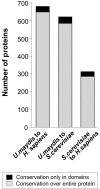The fungus Ustilago maydis and humans share disease-related proteins that are not found in Saccharomyces cerevisiae
- PMID: 18096044
- PMCID: PMC2262911
- DOI: 10.1186/1471-2164-8-473
The fungus Ustilago maydis and humans share disease-related proteins that are not found in Saccharomyces cerevisiae
Abstract
Background: The corn smut fungus Ustilago maydis is a well-established model system for molecular phytopathology. In addition, it recently became evident that U. maydis and humans share proteins and cellular processes that are not found in the standard fungal model Saccharomyces cerevisiae. This prompted us to do a comparative analysis of the predicted proteome of U. maydis, S. cerevisiae and humans.
Results: At a cut off at 20% identity over protein length, all three organisms share 1738 proteins, whereas both fungi share only 541 conserved proteins. Despite the evolutionary distance between U. maydis and humans, 777 proteins were shared. When applying a more stringent criterion (> or = 20% identity with a homologue in one organism over at least 50 amino acids and > or = 10% less in the other organism), we found 681 proteins for the comparison of U. maydis and humans, whereas the both fungi share only 622 fungal specific proteins. Finally, we found that S. cerevisiae and humans shared 312 proteins. In the U. maydis to H. sapiens homology set 454 proteins are functionally classified and 42 proteins are related to serious human diseases. However, a large portion of 222 proteins are of unknown function.
Conclusion: The fungus U. maydis has a long history of being a model system for understanding DNA recombination and repair, as well as molecular plant pathology. The identification of functionally un-characterized genes that are conserved in humans and U. maydis opens the door for experimental work, which promises new insight in the cell biology of the mammalian cell.
Figures





Similar articles
-
Ustilago maydis, a new fungal model system for cell biology.Trends Cell Biol. 2008 Feb;18(2):61-7. doi: 10.1016/j.tcb.2007.11.008. Trends Cell Biol. 2008. PMID: 18243705 Review.
-
Transcriptome analysis of smut fungi reveals widespread intergenic transcription and conserved antisense transcript expression.BMC Genomics. 2017 May 2;18(1):340. doi: 10.1186/s12864-017-3720-8. BMC Genomics. 2017. PMID: 28464849 Free PMC article.
-
An Ustilago maydis gene involved in H2O2 detoxification is required for virulence.Plant Cell. 2007 Jul;19(7):2293-309. doi: 10.1105/tpc.107.052332. Epub 2007 Jul 6. Plant Cell. 2007. PMID: 17616735 Free PMC article.
-
The posttranscriptional machinery of Ustilago maydis.Fungal Genet Biol. 2008 Aug;45 Suppl 1:S40-6. doi: 10.1016/j.fgb.2008.03.013. Epub 2008 Mar 31. Fungal Genet Biol. 2008. PMID: 18468465 Review.
-
Gene discovery and transcript analyses in the corn smut pathogen Ustilago maydis: expressed sequence tag and genome sequence comparison.BMC Genomics. 2007 Sep 24;8:334. doi: 10.1186/1471-2164-8-334. BMC Genomics. 2007. PMID: 17892571 Free PMC article.
Cited by
-
Homology length dictates the requirement for Rad51 and Rad52 in gene targeting in the Basidiomycota yeast Naganishia liquefaciens.Curr Genet. 2021 Dec;67(6):919-936. doi: 10.1007/s00294-021-01201-3. Epub 2021 Jul 22. Curr Genet. 2021. PMID: 34296348
-
In Silico Analysis of the Structural and Biochemical Features of the NMD Factor UPF1 in Ustilago maydis.PLoS One. 2016 Feb 10;11(2):e0148191. doi: 10.1371/journal.pone.0148191. eCollection 2016. PLoS One. 2016. PMID: 26863136 Free PMC article.
-
Heterologous expression and characterization of the aspartic endoprotease Pep4um from Ustilago maydis, a homolog of the human Chatepsin D, an important breast cancer therapeutic target.Mol Biol Rep. 2018 Oct;45(5):1155-1163. doi: 10.1007/s11033-018-4267-8. Epub 2018 Aug 3. Mol Biol Rep. 2018. PMID: 30076522
-
Phylogenetic profiling in eukaryotes: The effect of species, orthologous group, and interactome selection on protein interaction prediction.PLoS One. 2022 Apr 14;17(4):e0251833. doi: 10.1371/journal.pone.0251833. eCollection 2022. PLoS One. 2022. PMID: 35421089 Free PMC article.
-
Controlled and stochastic retention concentrates dynein at microtubule ends to keep endosomes on track.EMBO J. 2011 Feb 16;30(4):652-64. doi: 10.1038/emboj.2010.360. Epub 2011 Jan 28. EMBO J. 2011. PMID: 21278707 Free PMC article.
References
-
- Evans CS, Hedger JN. Degradation of plant cell wall polymers. In: Gadd GM, editor. Fungi in bioremediation. Cambridge, United kingdom: Cambridge University Press; 2001. pp. 1–26.
-
- Smith SE, Read DJ. Mycorrhizal symbiosis. New York: Academic Press, Inc; 1997.
-
- San-Blas G, Travassos LR, Fries BC, Goldman DL, Casadevall A, Carmona AK, Barros TF, Puccia R, Hostetter MK, Shanks SG, et al. Fungal morphogenesis and virulence. Med Mycol. 2000;38:79–86. - PubMed
Publication types
MeSH terms
Substances
LinkOut - more resources
Full Text Sources
Molecular Biology Databases

